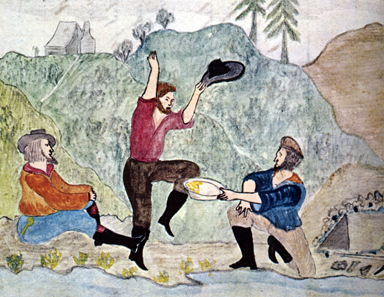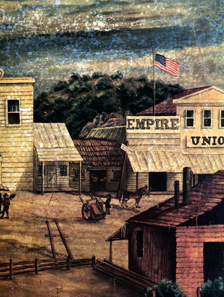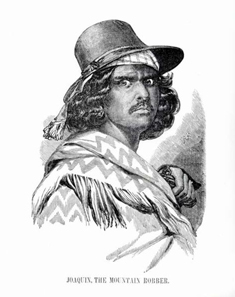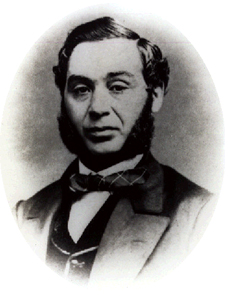Countless stories tell of the Californian gold rush which brought thousands of men to America, the Promised Land. But the gold made only very few rich. The majority died as a result of the exertion during the travel, the hard work and the disappointment when they returned back home, poorer than they had come. Their story should be told here.
The work
For now, however, we’re still at the very first stage, in which everyone – or so it seemed – only had to pick up the gold lying around on the ground. Some newcomers had exaggerated expectations about what they thought they might attain in the Promised Land. Thus, one of them told a curious reporter he cherished no great expectations whatsoever. When he got to pick up a hat or so full of gold, he would already be satisfied.
Actually, digging for gold was a tedious undertaking, collecting the gold from the ground was possible only at a very early stage. All the great gold deposits, which the rivers had transported over millennia from the mother lode down into the valley, were discovered in the beginning. Nests of gold had been developed at all natural obstacles, but they were soon depleted by the many gold diggers.
Nobody touched the real gold mines at first. The reason for that was quite simple. No individual owned the capital required to exploit an entire mine. Taken this into account, it becomes obvious at once why the gold digger’s success was destined to be temporary only: with their relatively primitive mining techniques they could only exploit deposits that had been developed over the course of millennia. But, since tens of thousands were searching it was just a matter of time that the last of these were discovered. Some gold prospectors tried to build subterranean shafts but they seldom reached deeper than one or two meters. That technique was called ‘coyoting’ after the coyote that tunneled his way into the ground in a similar manner. The actual exploitation of the mother lodes was to be left to the generations following the gold diggers.
Contemporary caricature of a gold prospector.
Hardly any gold digger was an expert. On the other hand, the things that were necessary to do that job were rather easy to learn. The techniques applied were so simple that anyone could master them. In most cases, the gold was washed out, which was a rather tedious task. All techniques used were based on the simple fact that gold is heavier than all other materials. Once the gold containing liquid was swirled, the gold sinks to the floor whereas the other contents are carried by the kinetic energy. That produced a number of methods with the simplest tools.
A gold prospector panning the precious metal using the gold pan.
The cheapest tool of all was the gold diggers’ pan – although that culinary utensil’s price rose from 20 cent to more than a dollar in the first phase of the gold rush. The gold containing earth was put into a flat pan and then the lighter material let slop out of it, over the rim. The heavier gold collected in the low base of the pan.
‘Long Tom’ – a canal with an artificially created sloping where the gold could be collected by the aid of inserted ledges.
And there was the more elaborate machine called Long Tom. It possessed a long canal for earth, mixed with water, running into it. Across the canal, ledges were nailed on that collected the heavier gold that sunk down onto the ground. By that, generally speaking, the arsenal of possible mining techniques was already complete.
Contemporary illustration of a gold find from 1853.
Success and failure
Hence, the technique of panning was easy to learn. More difficult was to decide where to turn to make the big discovery. There was no such thing as a map. So, the newcomers first turned their steps to the great centers of California, to Sacramento or San Francisco, to find their bearings. And there they were told fantastic stories, like, for example, the Californian variant of Uncle Tom’s Cabin: a gold prospector from the south had brought his slave with him. The latter had the same dream over and over again, that he would find gold underneath one of the shacks. His master then bought the shack, and master and slave together washed out gold worth 20,000 dollars out of the shack’s floor they had dug up.
Another story was about the unlucky gold digger who, filled with anger, kicked against a rock. The rock tumbled over and a huge nugget was revealed. Or the dead prospector whose comrades wanted to see him buried decently. A pit was dug, and one of his comrades made a speech next to the open grave. Apparently, the priest was a very talkative one and so one of the mourners kneeling got bored. He let sand trickle through his fingers. Then, all of a sudden, he cried out: he had discovered gold. The funeral was stopped, the corpse retrieved from the pit and the funeral party started to dig for gold.
Rumors were omnipresent. After all, everyone hoped for the one big find. We know from a letter how such a rumor sounded like. “We have been told, confidentially,” wrote a gold prospector called Leeper, “that someone had confirmed that someone had seen a man who had heard another one telling he knew a young man who was absolutely positive that he was acquainted to another guy who, and that he knew for certain, was a member of a group that rolled out large lumps of gold.”
A contemporary joke subsumes the gold diggers’ psychological state of mind: the gold prospector John Brown knocks onto heaven’s door. Saint Peter refuses to let him in, in his heaven there were far too many gold diggers already. John suggested to Peter a deal: if he successfully got rid of all the gold diggers in one week-time he would be allowed to stay. Peter agrees, and John starts working by pointing out, confidentially, to one or two, that gold had been found in hell. Not a week goes by, and John Brown sits all alone in heaven. Eventually, he asks Peter to let him go so he could also go to hell. “But why,” asks Peter, “I mean, it was you who had started the rumor in the first place?” “Well,” replied John Brown, “perhaps there is something to it after all.”
Spending a life in deficiency
When as rumor had been verified, when gold had actually been found that guaranteed a number of gold prospectors a living, it took but a short period of time for a small village to emerge. The Americans call these settlements Shantytowns. Shanty is colloquial for shack or a cabin, and the gold digger settlements really weren’t anything more than a collection of wooden cabins.
The mining community Mormon Island. This picture was taken between 1849 and 1854.
They were given fanciful names, like Grizzly Flats, Hang Town or Ben Hur, with a store as its most essential part, where the miners supplied themselves with everything the needed.
Such a store served as tavern, bar and inn, grocery, bank, exchange office and news market. To its owner, it was a virtual gold mine because every gold digger was forced to go there in order to acquire everything he needed for his living. Only in rare cases had a mining camp more than one such store; and that gave its owner the monopoly. The prices were breath-taking. An appalled reporter wrote in the Illustrated California Press about a breakfast he had taken in the gold fields:
“Mac and I went to have breakfast. It consisted of the following parts: one sardine can, one pound of hardtack, one pound of butter, half a pound of cheese and two bottles of beer. We ate and drank with a good appetite, and when we finished our meal, we asked for the bill. It was such a curiosity in the retail annals that I kept it and would like to publish it here. One sardine can, 16 $; one pound of hardtack, 2 $; half a pound of butter, 6 $; half a pound of cheese 3 $; two bottles of beer 16 $; that adds up to 43 $.”
We know from other sources as well that living expenses were incredibly high in the camps. Potatoes and onions, used to prevent scurvy, cost one dollar each. A keg of flour cost as much as 800 $.
Since California produced almost nothing by itself, all goods had to be shipped there. San Francisco was the main transshipment center. There, the shipments were sold to the highest bidding wholesaler who sold them on to retailers. The latter transported the goods to the far away mining communities. That was so expensive that the end price of the products were often sold by weight – which made a kilo of nails cost exactly the same as a kilo of apples or cheese. The original purchase price was negligible against the high carrying charges.
It goes without saying that the retailers accepted this difficult transport not out of charity but because they wanted to earn a healthy profit. 25 % weren’t considered ordinary but modest. Bad weather, which cut some camps from supplies for months, could easily boost the profit margin as high as 400 % and more. The merchants were the lucky ones in the gold rush. They had a relatively small risk, and yet realized vast profits.
Only when the exploitation of the mother lodes required bigger capital, they stepped into the breach with their fortune gathered.
It was a much more difficult task for a gold miner to make a fortune with his work. In 1849, he had to get gold out of the earth worth 5 $ in order to meet his incidental costs. The average yield, however, was 1.80 $ in Placerville, and 1.65 $ in Angels Camp. No wonder then, that most of the miners got nowhere.
After 1850, most of the dealers had adjusted themselves to the new needs and the prices for food were going down. Thus, between 1851 and 1855 gold mining became profitable again, but after 1856 the daily yield declined to such an extent that the individual miners were no longer able to stay in business. They could only leave or work at one of the newly established mining companies.
Xenophobia amongst the gold prospectors
Foreigners were in the gold diggers’ bad books. Particularly the South Americans and Mexicans were hit by it. Not only had they arrived much earlier in California thanks to the shorter way there; they often were much more up to date regarding mining than the American farmers, lawyers and doctors. Chased were not only Mexicans, but Californios as well, those Californians born in California of Mexican or Spanish descent, who were considered citizens of the United States after California had been acquired. There have been more than one attack on individual foreigners, and even pogroms happened.
Portrait of Joaquin Murrieta from 1853.
The Mexicans looked for an escape of their own. Many put up resistance in form of racketeering. Joaquin has become famous, a kind of Mexican Robin Hood, who frightened Calaveras County in the winter of 1852/53.
He was imputed with a horrible but apparently quite authentic fate. The Yankees were said to have had him flogged, his wife raped, his brother killed, his claim as well his flock stolen. In revenge he robbed the rich Americans and gave presents to the poor. The government sent 20 rangers to run him down. It took them three months to catch a band of Mexicans. They killed and beheaded their leader, preserved it in alcohol and exhibited it as Joaquin in several mining communities. It is, however, not proven beyond doubt that it really was Joaquin. The newspaper Alta California reported that the rangers had ambushed a group of seven local Californians who roped in feral mustangs. We can’t check the truth content of this story anymore. To get the gist of it, we see what was regarded possible in judicature back then. By the way, the government even promoted xenophobia. It had the “foreign miners tax” charged, a tax amounting to 20 $ every month for every foreigner who wanted to dig for gold in California. Given an average income of 1.65 $ a day, that was as much as the yield of 12 good days. That was too much. Instead of the anticipated 2,400,000 $ every year, the state only got 30,000 $. Most of the foreigners preferred retirement over paying that ruinous tax.
Löb Strauß, *26th February in Buttenheim / Oberfranken, + 26th September 1902 in San Francisco, known as Levi Strauss, inventor of the Blue Jeans.
It was perhaps due to this that some foreigners made legendary careers. Thrown back on commerce or handcraft, they squeezed gold out of their customers without any greater risk. Possibly the most famous of these successful entrepreneurs is Levi Strauss, who used to be called Löb Strauss back in his native town in Oberfranken. He arrived in California in 1850 and realized immediately that the work clothing of the miners was in need of improvement. Instead of cotton or wool, Strauss used sailcloth for trousers and added rivets to the seams and the pockets that used to rip quite often. The jeans were born, that still are worn today as Levi’s.
If you missed part I, you can still read the text in the archive. Just click here.
In the next and final part you will learn what impact the gold rush had on the minting and what the coins look like that we owe to this era.












